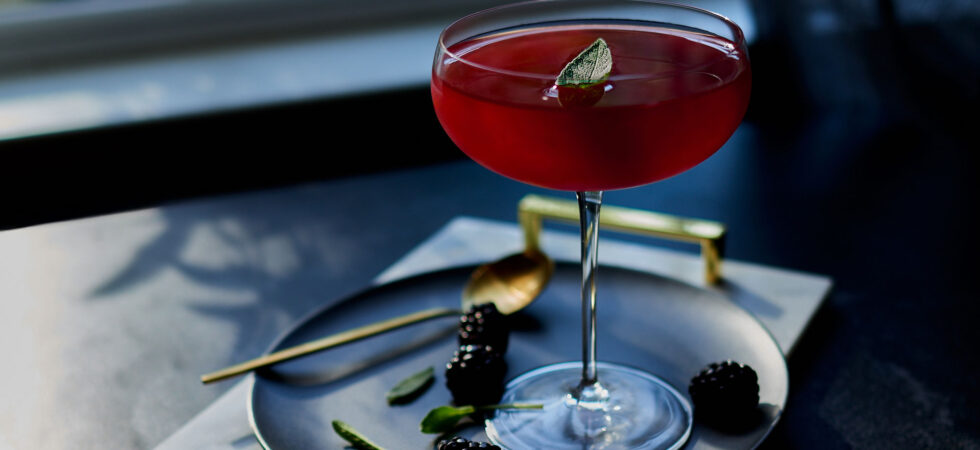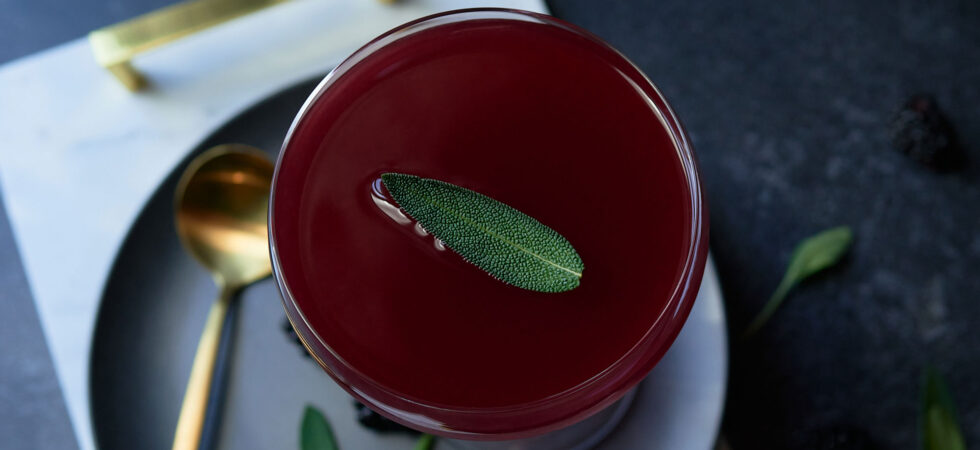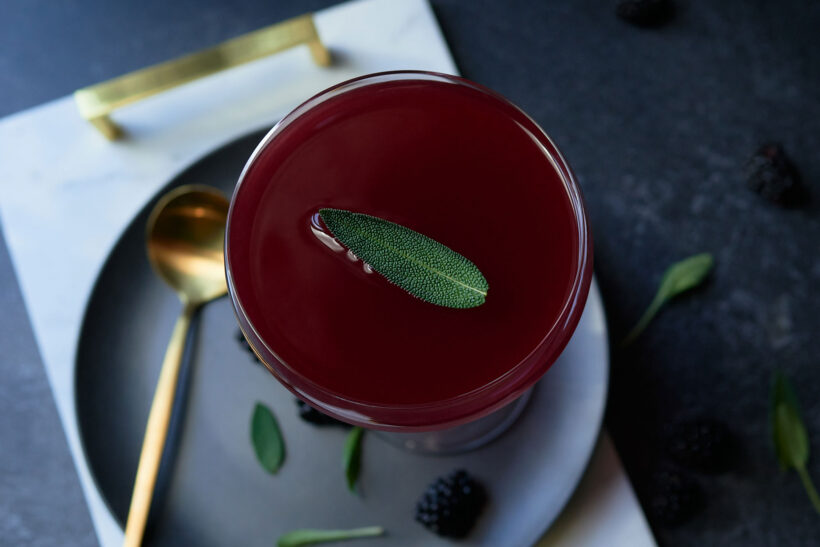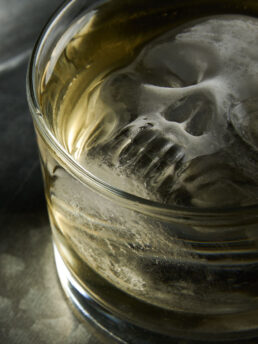Mezcal, Blackberry Shrub Cocktail

This Mezcal, Blackberry Shrub Cocktail is a copycat of the “Smoke & Mirrors” cocktail I had at Artillery Bar in Savannah, GA several years ago. It’s fruity, tart, a little bit smokey, and has just a hint of herbaceousness. I wouldn’t say it’s crushable, like most summer drinks are made to be, but I would say it’s absolutely delicious and interesting to the last drop. I don’t know about you, but sometimes I want to savor every sip of my cocktails.

Get the Recipe: Mezcal Blackberry Shrub Cocktail
Ingredients
Blackberry Shrub Syrup
- ⅓ cup granulated sugar
- ¼ cup fresh blackberries
- 2 tablespoons white distilled vinegar, see FAQs for subs
- zest of 1/2 lemon
Mezcal Blackberry Shrub Cocktail
- 2 oz Del Maguey Vida Clásico mezcal, See FAQs for subs
- 1½ oz blackberry shrub syrup
- 1 oz Yellow Chartreuse liqueur
- ½ oz fresh lemon juice
- 1 dash Scrappy's aromatic bitters
- 2 dashes Scrappy's creole bitters
- 1 large sage leaf
Equipment
- 2 containers with lids
- measuring Cups
- 1 kitchen scale (optional)
- 1 microplane or fine mesh grater
- 1 Fine Mesh Strainer
- 1 cutting board
- 1 paring knife
- 1 citrus juicer or reamer (optional)
- 1 cocktail shaker
- 1 blender (very optional)
- 1 coupe glass
Instructions
Blackberry Shrub Syrup
- In a medium container, with a lid, add the blackberries, sugar, and lemon zest. Toss to coat, cover, and let it sit out on the countertop for 24 hours, mixing every few hours or so. By the next morning most of the berries should be broken down and the bowl should contain a dark purple liquid. Mash the last bits of berry up with the back of a spoon and strain into a separate glass or plastic container with a lid.
- Next, add the vinegar to the syrup and whisk well to incorporate the ingredients. Little-by-little, add additional vinegar up 3 tablespoons (45ml), to taste. This shrub syrup should be quite tart but still have a very present sweetness. This a strong lemonade.
Mezcal Blackberry Shrub Cocktail
- Place a coupe glass in the freezer 15-30 minutes before making the cocktail. (see notes)
- Measure out and add all the ingredients, pouring each one into a cocktail shaker as you go. Drop in a large piece of ice, close, and shake for 30-45 seconds. Double strain into a chilled glass, sans ice.
- For garnish, lay a sage leaf on the heel of one hand and clap down on top of it with the other. It will release the oils of the leaf. Then, float the leaf right in the middle of the cocktail.
Notes
- Ripeness of the berries and how much you like acidity affects the amount of vinegar needed in the shrub syrup. I typically end up around (1 tbsp) 15ml of vinegar for berries that are not very ripe and increase to 2 tbsp (30ml) when they are sweeter.
- Don’t have distilled white vinegar? You can also use apple cider vinegar or champagne vinegar in a 1:1 substitution. (see FAQS for how each will affect flavor).
- Want to get more juice and a deeper color in your later cocktail? Blitz the sugar/berry mixture in the blender on low for about 30 seconds and then strain.
- If you’re happy with your final cocktail but whomever you are drinking with thinks it’s a little too tart, add a dash of falernum syrup or agave to their cocktail. This will sweeten it up a bit without diluting the flavor or adding extra alcohol.
- Leftover shrub? Use it with olive oil as a salad dressing, in smoothies to add a zing of acidity, or even over ice cream or breakfast foods. Even better, it lasts a really long time in the fridge. We’re talking like 6-8 weeks!
- If you forget to freeze your glass in advance, don’t panic. Simply add ice cubes to the glass, when you remember, and let them chill the glass while you make your cocktail. Dump the ice before you strain into your glass.
- If you use crushed ice in this cocktail it will water the whole thing down. The larger the ice cube(s) you use when shaking, the less surface area there is to melt and dilute your drink. Typically only very alcohol forward cocktails, like mint juleps use crushed ice.
Nutrition

Frequently Asked Questions
I get it, a day is a LONG time to wait for a cocktail. So, I did create a shortcut for the blackberry shrub syrup. It takes about 1 hour to make instead of 24 hours. The flavor will be sweeter and less berry forward, because the fruit and sugar aren’t allowed to sit for the full day. But it can work, if you just don’t have the time. I got you!
Instructions: Use the same measurements for the berries, sugar, and lemon zest. Put all three in a blender and give them a mix with a spoon until the berries are coated in purple sugar and look sandy. (Do NOT use the blender yet!) Let the berries and sugar sit for 30 minutes. Then, mash them with the spoon to release the juices from the berries. (Still NO blender) After another 30 minutes, top the blender and pulse for 15-30 seconds in 3-5 second increments. You want to see liquid and intact seeds. Strain the syrup through a fine mesh strainer and into a separate lidded container. Then, mix in the vinegar to taste. Since the syrup is sweeter, you might need between ½-1 tbsp (7.5-15ml) more vinegar to capture the same tang of the 24-hour syrup.
Yes, traditional shrub syrups are made with equal parts (by weight) fruit, sugar, and vinegar.
Why so little vinegar in my recipe you ask? Easy, because this cocktail isn’t diluted with soda water the way most shrub drinks are. If you made a traditional shrub syrup and used it undiluted, it would overpower all of the other ingredients. I like vinegar, but not THAT much!
For reference, your end goal for the syrup is to be about as pungent as a drinking vinegar or a completed shrub drink.
OF NOTE: Any additional vinegar is mostly going to depend on how ripe, sweet, and plump your berries are from the start. How much you like acidity, is going to be the rest of that equation.
If it helps, I typically end up around (1 tbsp) 15ml of vinegar for berries that are not very ripe and increase to 2 tbsp (30ml) when they are sweeter.
Oh yeah! Here are some options and what to expect when you use them:
1. White distilled vinegar (recipe): This vinegar has a sharp, clean, and acidic flavor with no residual sweetness. I use it for this recipe because it provides a brightness that allows the blackberries and lemon to shine.
2. Apple cider vinegar: This vinegar has a tangy, fruity, and slightly sweet flavor with a subtle apple undertone. It is less acidic (harsh) than white distilled vinegar and has notes of funkiness from the fermented apples used to make it. Using apple cider vinegar will better blend the other fruit flavors in this cocktail. But this also won’t let them stand out individually. So, if you want a more mellow, less tart cocktail this is the way to go.
3. Champagne vinegar: Made from the fermentation of champagne or sparkling wine, this vinegar is delicate, light, crisp, and slightly floral in flavor. It is also less harsh than both white distilled vinegar and apple cider vinegar. If you use Champagne vinegar instead of white distilled vinegar, expect a sweeter, more mellow result than even the apple cider vinegar can provide. It will also have a slightly cleaner taste than the apple cider vinegar, but the fruited origin of the vinegar will still impart additional flavor not present in the white distilled vinegar.
If you do decide to use one of the other vinegars listed, I suggest you start with the listed recipe amount and then add to your tastes a bit at a time.
It’s like you don’t even know me! Of course there are!
Honestly, any strong, sweet berry can work with this recipe. So, consider making a shrub syrup with blueberries, strawberries, marionberries, etc.
Feel free to riff by adding herbs and spices directly to the syrup as well. Think, cracked black pepper or sage, to tie in the garnish. Thyme, rosemary, and basil could work as well, depending on the berries used.
Use about 5% of the weight of the berries for each ingredient, so 4.5g if you use 90g of berries for a relatively safe, yet strong, place to start. Then, adjust the ingredients from there. Have fun!
This cocktail works best with joven mezcals made from Espadín (agave angustifolia), Tobalá ( agave potatorum), Cuishe or Madrecuixe (both of which are a subspecies of agave karwinskii). To choose something that mixes well with blackberries and lemon, look for tasting notes of verbena, green herbs, florals, citrus, leather, and/or fruit in the bottle/online description. I suggest Del Maguey (Vida Clásico specifically), Banhez, Bosscal, and Bozal Ensamble. I’ve seen those brands widely stocked, so they should be relatively easy to procure.
Of Note: About 80-90% of mezcals are made from Espadín. Expect to see mezcals made from espadín far more often and cheaper in price than the other agaves listed. Espadín is less fibrous and higher in sugar than other agave varieties. It also grows larger and faster than other varieties, aside from blue agave (tequilana). I’m sure you can guess what that subspecies is used for. 😉
Yellow Chartreuse is a French herbal liqueur made by Carthusian monks at the Grande Chartreuse monastery in Voiron, France. It is golden-yellow color and has a complex balance of sweet, herbal, and floral notes. Yellow Chartreuse, along with a variety of aromatic herbs, has flavors similar to honey, saffron, and ginger. It also has a slightly lower alcohol content than Green Chartreuse, around 40% alcohol by volume (ABV).
Because it is milder and slightly sweeter than Green Chartreuse, Yellow Chartreuse pairs well with citrus, spices, and other herbal liqueurs.
I know you’re curious: Green Chartreuse has a distinctive green color, which comes from the chlorophyll-rich herbs used in its production. It has a high alcohol content, typically around 55% alcohol by volume (ABV), and a very complex flavor profile. The taste of Green Chartreuse is bold and aromatic, with flavors of mint, anise, fennel, juniper, and a variety of other botanicals.
Quick answer: YES! Use Strega Italian Herbal Liqueur (Italy’s answer to the French liqueur) or Michelberger Forest Herbal Liqueur.
Longer answer: For those who don’t know, there is a Chartreuse shortage that started with the pandemic and peaked between 2021-2022. It all started in the early 2000’s with the re-popularization of The Last Word cocktail. (equal parts Gin, Green Chartreuse, and Maraschino Liqueur). After that, bartenders began using both Yellow and Green Chartreuse in more and more of their craft cocktails and drink programs. When the pandemic hit, and people wanted to recreate their local bar’s cocktails, demand increased even more. And, thus the supply dwindled. Yep, you guessed it, that was when I developed this recipe (*face palm*). Bad timing. I know.
But, you’re in luck! The two liqueurs I listed above are great substitutes for Yellow Chartreuse. Just something to note, not to change your mind, expect more anise flavor in the Strega and a slight bitterness in the Michelberger that you won’t find in the Yellow Chartreuse.



